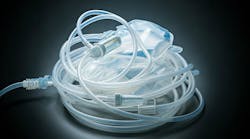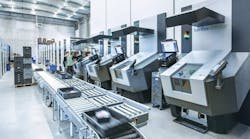The pharmaceutical industry’s desire to provide the highest quality products to protect consumers and their coveted brand image is paramount. Accordingly, manufacturers are always looking for new ways to eliminate foreign objects. In the past, the most common approach was metal detection, but certain factors that have plagued detectors—i.e. foil packaging, conductive products and ambient noise---gave rise to a superior technology: x-rays.
This is the main reason why cabinet x-ray systems are now being incorporated into pharmaceutical processing and packaging lines. Cabinet x-rays do so much more than detectors; they detect for contaminants, scan for missing tablets/capsules, monitor mass control, ensure product integrity and verify fill levels. They can also confirm the presence of leaflets and product count. The technology is useful for those processing both solid and liquid products.
Advantages of a Cabinet X-Ray System
Cabinet x-rays use radiation---the transmission of energy by means of particle waves---to inspect products. This invisible radiation, capable of penetrating solid material, is effective for seeing inside packages.
X-ray systems are ideal for scanning products for foreign objects after they are packaged, and especially useful for scanning foil blister packs and tablet/capsule containers with foil safety seals. Therefore, new Good Manufacturing Practices (GMPs) are now being written by processors to inspect the final package with an x-ray system so there is no danger of a contaminant getting inside the package before shipment. Simple metal detectors cannot be used effectively as the foil will disrupt the balanced field which, invariably, offers users poor sensitivity.
Additionally, cabinet x-ray machines are excellent for scanning finished goods and confirming the product is both present and has its integrity. For example, if a blister pack count is ten, the x-ray system will examine the product to ensure that all ten tablets are present. The system’s sophisticated algorithm analyzes the product and detects when tablets are crushed or broken and verifies that the informational leaflet is contained within the package.
However, with all of its sophistication, x-ray systems do have limitations as this technology cannot detect every kind of contaminant. For example, it will not detect certain types of plastic, or organic foreign objects such as hair, insects or wood, as these have similar atomic make-up of the product and little grey-scale difference. However, they will detect unwanted metals and glass and other less commonly found foreign objects in pharmaceutical processing, like stone and calcified bone.
Operation of a Cabinet X-Ray
Product inspection is achieved through a computer-controlled family of low-energy generators and a high performance computer image analysis system. Advanced linear array technology makes cabinet x-ray systems superior at detecting small statistical variations in the product that signal contamination or deviation from accepted specifications.
Pennsylvania-based Eriez (www.eriez.com) manufactures cabinet x-rays that also include a conveyor with a reject device. Eriez' cabinet x-ray models include external USB connectors for communication and instantaneous 24/7 troubleshooting.
Processing software provided by Eriez provides immediate analysis, detection and rejection--automatically. The system logs the date, time and type of reject. It also saves an inspection image of the product so inspectors can view the contaminant.
The way the contaminant is positioned within the packaging does have an effect on its detectability. An x-ray beam is 2-3 mm thick and is directed toward a silicon array of diodes (a device that looks for photons or light). If a foreign object is perpendicular to the beam, it is less detectable because it is less dense. If the object is vertical (or on plane with the beam), it is more dense and therefore more detectable.
Typically, x-ray systems are designed with rugged stainless steel cabinets suitable for wash down, large color touch screen display (normally 15") and a range of reject devices. These systems can accommodate most production line belt widths as well as loose product or packages.
Cabinet X-Rays: The Safety Factor
X-ray systems can be installed on most conveyer lines (packaged or bulk) or pipelines. The tank (or device which generates the x-rays) is always installed in an enclosure—called the cabinet--, which protects operators from scattered emissions and excludes operators from the enclosure’s interior.
Most manufacturers like Eriez offer a range of systems at various costs to handle diverse applications. Prices of cabinet x-ray systems start as low as $40,000, with costs dependent on the customer’s unique needs and the configuration of the system.
Manufacturers such as Eriez are required to certify their product meets US Federal radiation safety performance standards for cabinet x-ray systems. The standard requires that radiation emitted not exceed an exposure of .5 milliroentgens in one hour at any point five centimeters from the external source. Eriez X-Ray Systems emit less than this limit.
For comparison, the average person in the United States receives a dose of about 360 millirem of radiation per year from background radiation, which is always present in the environment. Eighty percent of that exposure comes from natural sources: radon gas, the human body, outer space, rocks and soil. The remaining 20 percent comes from man-made sources, primarily x-rays.
Man-made x-ray sources include airport, medical and dental x-ray machines, as well as projection televisions and irradiated tobacco, to name a few. Most of the emission levels from these sources far exceed the levels emitted from cabinet x-rays. A well designed system will have emission levels that are almost immeasurable
FDA Guidelines—a Brief Look at CFR 1020.40 Regulations
To operate cabinet x-ray machinery in an industrial environment, strict guidelines are set forth by the Federal government. Accordingly, manufacturers like Eriez must comply with FDA 21 CFR 1020.40 to ensure the machines are safe.
The FDA requires that x-ray systems include safety features such as a light tower (visible 360 degrees around the system that displays the x-ray status), emergency stop buttons, key lock, curtains, tunnel covers with dual interlocks and appropriate safety signage.
The safety interlocks, which disconnect power to the x-ray generator if opened, are put on doors and tunnel covers. As a failsafe, some machines will have two circuits passing though these interlocks, in the event that one becomes inoperable.
There are no known adverse effects from digesting a pharmaceutical tablet/capsule that has been scanned by a cabinet x-ray system as the measured energy levels are very low in thousand electron volt or KeV range. To induce changes in a product, or to sterilize a product, very powerful beams of radiation are required in the range of 5-10 million electron volts or MeV. The radiation dose typically received by pharmaceutical objects scanned by a cabinet x-ray system is one millirad or less.
Operators of a cabinet x-ray system are not required to wear special protection. This technology is the same as x-ray technology used in airports; personnel there do not need special protection either.
State and Provincial Regulations
Equipment must be registered according to state and local regulations. Any company interested in using a cabinet x-ray must also develop a safety audit program, as well as operating and emergency procedures. A training program must also be developed. Retention of records is also mandatory, and a radiation safety officer or “responsible person” must be designated. But, it should be noted that there is no standard checklist of necessary steps.
X-Ray Material Testing
Historically, pharmaceutical manufacturers that wanted to test product using a cabinet x-ray system required sending product samples with imbedded contaminants to a system supplier and a test report would be generated. Sometimes, a representative from the pharmaceutical company will visit the x-ray system supplier on-site for the testing. This is costly and time consuming.
Now, using Internet-based technology, Eriez offers a “virtual” material test in real time through Online X-Ray Testing via interactive video on a password-protected Web site. Viewers can see actual contaminants passing through pre-sent material to determine the effectiveness of an Eriez X-Ray System in detecting foreign objects. Multiple viewers can watch from different locations and ask questions live to Eriez' on-site personnel.
Online testing precludes the need for a site visit, saving time and money, and allows more personnel to participate without leaving their facility.





